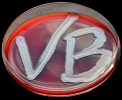| Species/Subspecies: | Ehrlichia canis | ||||||||
|---|---|---|---|---|---|---|---|---|---|
| Etymology: | Genus name: named after the German bacteriologist Paul Ehrlich (1854-1915). Species epithet: of dog. | ||||||||
| Significance: | The disease is normally not found in Sweden, as the brown dog tick requires a warmer climate in order to survive. Sick dogs may, however, occur after importing or stay abroad. [Of minor importance] |
||||||||
| Taxonomy: | Class Alphaproteobacteria Order Rickettsiales Family Anaplasmataceae Genus Ehrlichia |
||||||||
| Type Strain: | Oklahoma | ||||||||
| Macromorphology (smell): | Cannot be cultivaqted on cell free substrates (e.g. agar plates). | ||||||||
| Micromorphology: | Coccoid to elipsoid cells (about 0.5 µm in diameter), which are nonmotile. A morula (see below) can be up to 4 µm in diameter. | ||||||||
| Gram +/Gram -: | G- | ||||||||
| Catalase/Oxidase: | |||||||||
| Fermentation of carbohydrates: | Is not used for identification of Ehrlichia spp. Furthermore, many intracellular bacteria lack enzymes for carbohydrate metabolism because of evolutionary gene reduction. | ||||||||
| Spec. Char.: | |||||||||
| Special Media: | |||||||||
| Vector: | Brown dog tick(Rhipicephalus sangineus) | ||||||||
| Reservoir: | Canids | ||||||||
| Disease: | Canine monocytic ehrlichiosis. |
||||||||
| Hosts: | Canids (Canidae). Has also been reported in cats. | ||||||||
| Clinical Picture: | |||||||||
| Genome Sequence: |
|
||||||||
| 16S rRNA Seq.: |
| ||||||||
| Taxonomy/phylogeny:
|
Seven species have been described within the genus Ehrlichia, which is most closely related to the genus Anaplasma. | ||||||||
| Comment: | Strictly intracellular and grows in inclusions (morulae) in monocytes. Morula refers to the mulberry-like structure (Morus= mulberry in Latin) of the inclusions . | ||||||||
| Updated: | 2023-03-22 |
